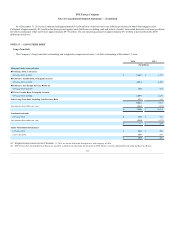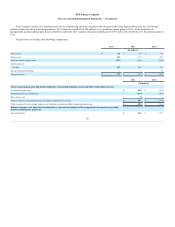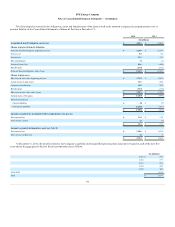DTE Energy 2014 Annual Report Download - page 90
Download and view the complete annual report
Please find page 90 of the 2014 DTE Energy annual report below. You can navigate through the pages in the report by either clicking on the pages listed below, or by using the keyword search tool below to find specific information within the annual report.
Lessor - Capital Lease — The Company leases a portion of its pipeline system to the Vector Pipeline through a capital lease contract that expires in
2020, with renewal options extending for five years. The Company owns a 40% interest in the Vector Pipeline. In addition, the Company has two energy
services agreements, a portion of which are accounted for as capital leases. One agreement expires in 2021. The other agreement expires in 2019, with a three
or five year renewal option. The components of the net investment in the capital leases at December 31, 2014, were as follows:
2015 $ 12
2016 13
2017 13
2018 13
2019 10
Thereafter 9
Total minimum future lease receipts 70
Residual value of leased pipeline 40
Less unearned income (34)
Net investment in capital lease 76
Less current portion (5)
$ 71
Electric
Air — DTE Electric is subject to the EPA ozone and fine particulate transport and acid rain regulations that limit power plant emissions of sulfur
dioxide and nitrogen oxides. The EPA and the State of Michigan have issued emission reduction regulations relating to ozone, fine particulate, regional
haze, mercury, and other air pollution. These rules have led to controls on fossil-fueled power plants to reduce nitrogen oxide, sulfur dioxide, mercury and
other emissions. To comply with these requirements, DTE Electric spent approximately $2.2 billion through 2014. The Company estimates DTE Electric will
make capital expenditures of approximately $100 million in 2015 and up to approximately $30 million of additional capital expenditures through 2019
based on current regulations.
Additional rulemakings are expected over the next few years which could require additional controls for sulfur dioxide, nitrogen oxides and other
hazardous air pollutants. The Cross State Air Pollution Rule (CSAPR), requires further reductions of sulfur dioxide and nitrogen oxides emissions effective
January 2015. DTE Electric expects to meet its obligations under CSAPR beginning in 2015.
The Mercury and Air Toxics Standard (MATS) rule, formerly known as the Electric Generating Unit Maximum Achievable Control Technology (EGU
MACT) Rule was finalized in December 2011. The MATS rule requires reductions of mercury and other hazardous air pollutants beginning in April 2015,
with a potential extension to April 2016. DTE Electric has requested and been granted compliance date extensions for all relevant units to April 2016. DTE
Electric has tested technologies to determine technological and economic feasibility as MATS compliance alternatives to Flue Gas Desulfurization (FGD)
systems. Implementation of Dry Sorbent Injection (DSI) and Activated Carbon Injection (ACI) technologies will allow several units that would not have been
economical for FGD installations to continue operation in compliance with MATS. In November 2014, the Supreme Court agreed to review a challenge to the
MATS rule based on a narrowly focused question of how the EPA considered costs in regulating air pollutants emitted by electric utilities. DTE Electric
cannot predict the financial impact or outcome of this Supreme Court case, or the timing of its resolution.
The EPA proposed revised air quality standards for ground level ozone in November 2014 and the standards are expected to be finalized by October
2015. DTE Electric will engage with the EPA and other stakeholders in commenting on this rule. DTE Electric cannot predict the financial impact of the
proposed ozone standards at this time.
87
























